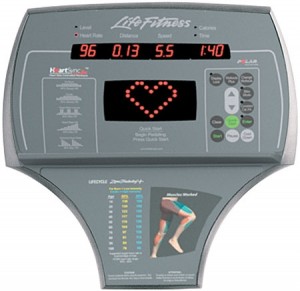Cycling with Screens
For the most part I track my daily activity in my head; I care about getting my work done and being healthy, but not enough to consistently use an app on my phone. However, this semester I am enrolled in an online aerobics gym class (ridiculous graduation requirement if you ask me) and I am required to record my heart rate during 3 workouts lasting at least 30 minutes. To do this, I head over to the gym and use the LifeCycle stationary bikes, which record tons of information such as: calories burned, heart rate, pace, speed, distance, level, time elapsed, and time remaining. There is also an option to input weight for more specific information, but I don’t bother with this. While at first I used the LifeCycle simply to meet the requirements of my class, I found that all of the extra information helped me to push myself further and workout longer and harder.
The machine is a completely different experience than a real bicycle. Cycling outdoors without all of this information on a screen in front of me is much more amusing, but not very useful for exercising. All these methods to quantify my workout help me to set goals that I simply don’t think of on a real bicycle. As I stare at the time ticking away I push myself to reach an hour rather than quitting when I get bored. As I look at the speed monitor, I push myself to go 15 miles/hour rather than at a more leisurely pace as I do outdoors. The LifeCycle is not as enjoyable as a ride on a real bicycle, but I do receive happiness from the satisfaction of setting and accomplishing goals that self-tracking makes possible.
As it pushes its users to go further by helping us to self-track, the machine shows its potential to change how we approach and control our personal physical fitness. As for its future, I’m not sure how much further it can be taken, but such easy access to our quantified self may be helpful information to give to our doctors who can use this information to help us better understand the state of our health.
To quickly address the last few questions on social media: the machine does not require access to social media and I don’t post about my quantified self. By virtue of the information being very specific only to one person, I find posts about other people’s quantified self to be uninteresting and unnecessary.

 Previous Post
Previous Post Next Post
Next Post
I agree that access to our quantified self can help doctors track and understand the state of our health in the future, which is pretty cool. I also agree that other people’s posts about their quantified self are pretty uninteresting, unless it is someone that is very important to me. For the most part it is just people looking for an ego boost, which is annoying.
I think self-tracking is useful when it comes to exercise because it’s a way to keep track of personal goals when getting healthy. I haven’t used those specific ones that you mentioned, but I have tracked myself through the machinery used in my apartment’s gym, and I agree that it does help push me harder when I exercise.
Although not an app, I think highlighting the self tracking of a PE class here at state is cool and unique. Self tracking really stems back a long way, but the means of how we track are vastly changing. Maybe we should have put up a bike stats tracking app on the board last week. I’m sure it wouldn’t take long to draw up an adequate mounting device for a phone, and then you can have all the amusement of riding outside and all the goal-setting data of riding on a stationary bike.